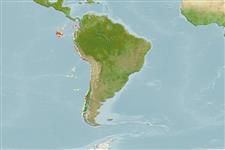Olocefali (chimere) (chimaeras) >
Chimaeriformes (Chimaeras) >
Chimaeridae (Shortnose chimaeras or ratfishes)
Etymology: Hydrolagus: hydro-, combining form of hydor (Gr.), water; lagos (Gr.), hare, i.e., “water rabbit,” probably referring to three pairs of tooth plates, which tend to protrude from the mouth like a rabbit’s incisors. (See ETYFish); alphus: Greek for a white spot on the skin, referring to noticeable white spot on sides. (See ETYFish).
Environment: milieu / climate zone / depth range / distribution range
Ecologia
marino batidemersale; distribuzione batimetrica 600 - 900 m (Ref. 57721). Tropical
Distribuzione
Stati | Aree FAO | Ecosystems | Presenze | Point map | Introduzioni | Faunafri
Eastern Central Pacific: Galapagos Islands.
Size / Peso / Age
Maturity: Lm ? range ? - ? cm
Max length : 41.9 cm TL maschio/sesso non determinato; (Ref. 57721); 48.0 cm TL (female)
Short description
Morfologia | Morfometria
Assigned to the genus Hydrolagus based upon the absence of an anal fin. Hydrolagus alphus is distinguished by being medium in size (average PCL 321 mm) and uniform dark brown in color with a distinct white spot (4%-6% BDL) on the lateral side above the pectoral fins. Paired fins with bluish hue and white margins. The dorsal spine longer than triangular shaped first dorsal fin and extends beyond the origin of the second dorsal fin when depressed. Eyes large (40.8–44.5% HDL) and pectoral fins reaching to or beyond insertion of pelvic fins when depressed. Pelvic claspers small, not extending beyond distal edge of pelvic fin, and divided distally for one half their length with slender fleshy denticulate tips. The base of second dorsal fin is long, deeply depressed and light colored in the center, anterior and posterior regions dark, considerably greater in height than the white middle region (Ref. 57721).
Life cycle and mating behavior
Maturità | Riproduzione | Deposizione | Uova | Fecundity | Larve
Quaranta, K.L., D.A. Didier, D.J. Long and D.A. Ebert, 2006. A new species of chimaeroid, Hydrolagus alphus sp. nov.(Chimaeriformes: Chimaeridae) from the Galapagos Islands. Zootaxa 1377:33-45. (Ref. 57721)
IUCN Red List Status (Ref. 130435)
Threat to humans
Harmless
Human uses
Informazioni ulteriori
StatiAree FAOEcosystemsPresenzeIntroduzioniStocksEcologiaDietaPredeConsumo di ciboRazione
Nomi ComuniSinonimiMetabolismoPredatoriEcotossicologiaRiproduzioneMaturitàDeposizioneSpawning aggregationFecundityUovaEgg development
Age/SizeAccrescimentoLength-weightLength-lengthLength-frequenciesMorfometriaMorfologiaLarveDinamica popolazioni larvaliReclutamentoAbbondanzaBRUVS
BibliografiaAcquacolturaProfilo di acquacolturaVarietàGeneticaElectrophoresesEreditarietàMalattieElaborazioneNutrientsMass conversion
CollaboratoriImmaginiStamps, Coins Misc.SuoniCiguateraVelocitàModalità di nuotoArea branchialeOtolithsCervelliVista
Strumenti
Special reports
Download XML
Fonti Internet
Estimates based on models
Preferred temperature (Ref.
123201): 3.7 - 7, mean 5.7 °C (based on 7 cells).
Phylogenetic diversity index (Ref.
82804): PD
50 = 0.5000 [Uniqueness, from 0.5 = low to 2.0 = high].
Bayesian length-weight: a=0.00282 (0.00118 - 0.00673), b=3.10 (2.89 - 3.31), in cm total length, based on LWR estimates for this (Sub)family-body shape (Ref.
93245).
Trophic level (Ref.
69278): 3.7 ±0.6 se; based on size and trophs of closest relatives
Resilienza (Ref.
120179): Basso, tempo minimo di raddoppiamento della popolazione 4.5 - 14 anni (Deep-water species, few large eggs.).
Fishing Vulnerability (Ref.
59153): Moderate vulnerability (38 of 100).
